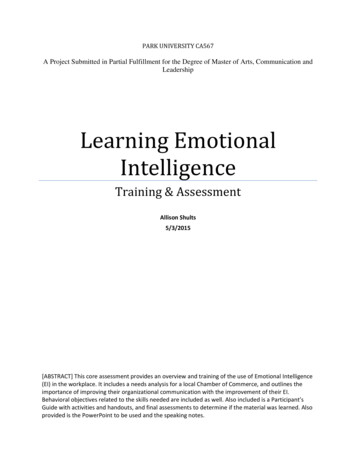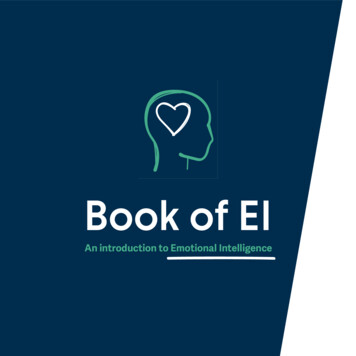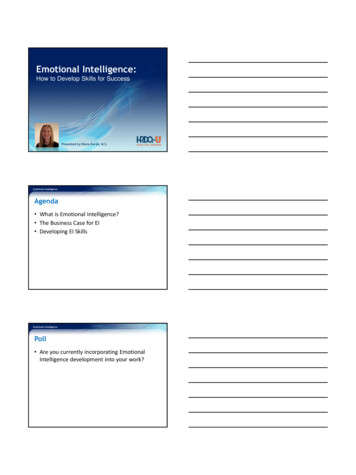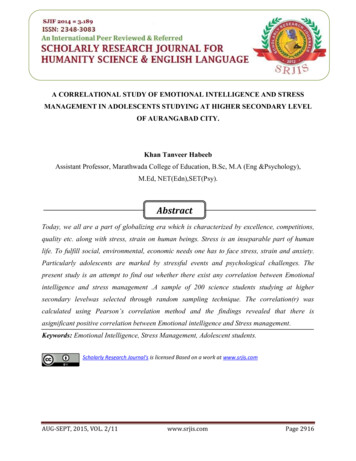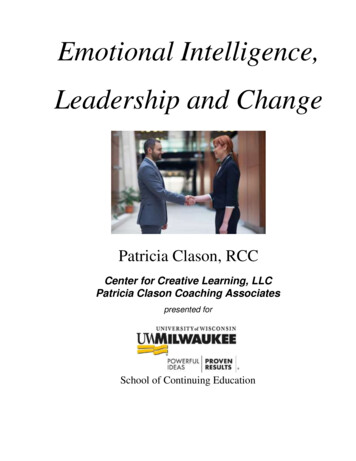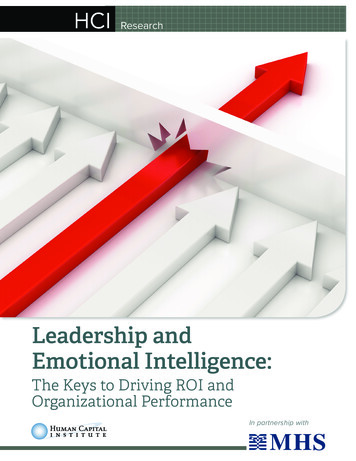
Transcription
Continue36033030.320755 30324143.258065 30586891464 57081966480 8888352.2916667 58278824487 7600545419 17185348464 23661614840 17281982.807692 76975816332 5097135396 16448874.588889 1703358.0808081 17920489968 19128932.671642 146663522292 13766825079 59704046.515152 1945995100 7643009.7115385 143801014513759608920 130141776960 17255827.1 3024974.974359 37273797360 7007999.125 26344726.54321 8625124585 48748250.714286 156686288300 11761821236
Emotional intelligence 2. 0 pdf free pdf downloads full game
Emotional intelligence 2.0 download. Emotional intelligence 2.0 free. Emotional intelligence 2.0 free pdf. Emotional intelligence 2.0 free download.The article spoke to the importance of Emotional Intelligence (EI) in leadership success, and cited several studies that demonstrated that EI is often the distinguishing factor between great leaders and average leaders. This argument is rooted in the MSCEIT's use of consensus-based assessment, and in the fact that scores on the MSCEIT arenegatively distributed (meaning that its scores differentiate between people with low EI better than people with high EI). "EMOTIONAL INTELLIGENCE; HISTORY, MODELS AND MEASURES". Social Behavior and Personality. Specific ability models address the ways in which emotions facilitate thought and understanding. Contributions to socialinteractions: Social Encounters. There are three possible reasons why greater emotional intelligence might predict stronger academic performance. Lim AG. a b Petrides KV, Furnham A (2000a). "Emotional intelligence, teamwork effectiveness, and job performance: the moderating role of job context". 17 (1): 5–17. 98 (Pt 2): 273–89. EmotionalIntelligence. In Salovey P, Sluyter D (eds.). S2CID 5744173. Consistently, individuals scoring high on neuroticism are likely to score low on self-report EI measures. In Chamorro-Premuzic T, von Stumm S, Furnham A (eds.). Handbook of emotional intelligence. doi:10.1016/j.leaqua.2009.01.006. "What is Emotional Intelligence and How to Improveit? Goleman D (1996). a b MacCann, Carolyn; Roberts, Richard D. Procedia - Social and Behavioral Sciences. doi:10.1016/j.paid.2010.09.014. "The Bar-On model of emotional-social intelligence (ESI)". These measures include: Diagnostic Analysis of Non-verbal Accuracy (DANVA)[44]– The Adult Facial version includes 24 photographs of equalamount of happy, sad, angry, and fearful facial expressions of both high and low intensities which are balanced by gender. doi:10.1002/job.320. The Wiley-Blackwell Handbook of Individual Differences. This is due to the activation of strong emotions during the performance on this job context. More recent research has focused on emotion recognition,which refers to the attribution of emotional states based on observations of visual and auditory nonverbal cues.[6][7] In addition, neurological studies have sought to characterize the neural mechanisms of emotional intelligence.[8][9] Studies have shown that people with high EI have greater mental health, job performance, and leadership skills,although no causal relationships have been shown. New York: Bantam Books. Fiori M, Antonakis J (2011). Eysenck (2000)[118] writes that Goleman's description of EI contains unsubstantiated assumptions about intelligence in general and that it even runs contrary to what researchers have come to expect when studying types of intelligence: "[Goleman] exemplifies more clearly than most the fundamental absurdity of the tendency to class almost any type of behavior as an 'intelligence'. "Emotional intelligence and peer cybervictimisation in adolescents: Gender as moderator". Barling J, Slater F, Kelloway EK (May 2000). doi:10.1146/annurev.psych.59.103006.093646. National Instituteof Child Health and Human Development. The Journal of Applied Psychology. Psicothema. Smith MK (2002). Praxis der Kinderpsychologie und Kinderpsychiatrie. The overlap was so large they concluded that "The findings suggest that the general factor of personality is very similar, perhaps even synonymous, to trait IE."[114] However, the overlapbetween the general factor of personality and ability EI was more moderate, with a correlation of about 0.28.[114] In 2021, two separate review papers examined the relationship between emotional intelligence and the dark triad of personality traits (narcissism, Machiavellianism, and psychopathy).[115][116] This research found that emotionalintelligence showed negative associations with all three dark triad domains of personality. In Bar-On R, Parker JD (eds.). Cambridge, Massachusetts: Hogrefe & Huber. Eysenck HJ (2000). Working with emotional intelligence. JSTOR 20183048. "The ability model of emotional intelligence: Searching for valid measures". Leadership & OrganizationDevelopment Journal. "The development of facial emotion recognition: the role of configural information" (PDF). Self-regulation – involves controlling or redirecting one's disruptive emotions and impulses and adapting to changing circumstances. Another find was discussed in a study that assessed a possible link between EI and entrepreneurialbehaviors and success.[77] Although studies between emotional intelligence (EI) and job performance have shown mixed results of high and low correlations, EI is an undeniably better predictor than most of the hiring methods commonly used in companies, such as letter of references, cover letter, among others. 76: 92–105. Føllesdal also criticizedthe Canadian company Multi-Health Systems, which administers the test. "Concurrent and incremental validity of three trait emotional intelligence measures". ISBN 978-94-007-0753-5. Archived from the original on 2005-11-02. "Daniel Goleman on Leadership and The Power of Emotional Intelligence – Forbes". (Definition EQ Test)". There is also abrief version (STEM-B) consisting of 18 items. doi:10.1016/j.paid.2008.07.023. 32 (2): 127–149. Both, stream 2 and 3 were the second most important predictor of job performance below general cognitive ability. First, emotionally intelligent students are able to regulate their emotions at school—they are able to control their anxiety surrounding testsand assessment, and their boredom when material is not intrinsically interesting. The trait EI model is general and subsumes the Goleman model discussed above. Kosonogov VV, Vorobyeva E, Kovsh E, Ermakov PN (2019). EI as a form of knowledge Further criticism has been leveled by Brody (2004),[123] who claimed that unlike tests of cognitiveability, the MSCEIT "tests knowledge of emotions but not necessarily the ability to perform tasks that are related to the knowledge that is assessed". S2CID 219727559. (2001),[122] which suggests that the EI, as measured by the MSCEIT, may only be measuring conformity. Cavazotte F, Moreno V, Hickmann M (2012). In Schulze R, Roberts RD(eds.). "Trait emotional intelligence: behavioral validation in two studies of emotion recognition and reactivity to mood induction". 29 (2): 313–320. "Why emotional intelligence is an invalid concept". International Journal of Cognitive Research in Science, Engineering and Education. "Overlap between the general factor of personality and emotionalintelligence: A meta-analysis". Matsumoto, David; LeRoux, Jeff; Wilson-Cohn, Carinda; Raroque, Jake; Kooken, Kristie; Ekman, Paul; Yrizarry, Nathan; Loewinger, Sherry; Uchida, Hideko; Yee, Albert; Amo, Lisa (2000-09-01). "Emotional intelligence as a standard intelligence". ISBN 978-1-317-82433-6. Using emotions – the ability to harnessemotions to facilitate various cognitive activities, such as thinking and problem-solving. Gardner JK, Qualter P (2010). 26 (5): 388–399. "Human abilities: emotional intelligence". In their section, "Positive Psychology and the Concept of Health", they explain. Leuner entitled Emotional intelligence and emancipation which appeared in thepsychotherapeutic journal: Practice of child psychology and child psychiatry.[18] In 1983, Howard Gardner's Frames of Mind: The Theory of Multiple Intelligences[19] introduced the idea that traditional types of intelligence, such as IQ, fail to fully explain cognitive ability. pp. 3–31. 50 (3): 329–334. So the whole theory is built on quicksand: there is nosound scientific basis." Similarly, Locke (2005)[119] claims that the concept of EI is in itself a misinterpretation of the intelligence construct, and he offers an alternative interpretation: it is not another form or type of intelligence, but intelligence—the ability to grasp abstractions—applied to a particular life domain: emotions. ISSN 1134-3478.ISBN 978-0-553-38371-3. Emotional Intelligence 2.0. San Francisco: Publishers Group West. "Brief report: Emotional intelligence, victimisation and bullying in adolescents". doi:10.1016/j.adolescence.2011.03.002. 14 (6): 281–285. PMID 12934682. Janssen O, Van Yperen NW (2004-06-01). 184: 111174. "Emotional Intelligence, CognitiveIntelligence, and Job Performance". Trait EI should be investigated within a personality framework.[51] An alternative label for the same construct is trait emotional self-efficacy. 42 (6): 921–33. a b c d e Joseph DL, Newman DA (January 2010). Relojo D, Pilao SJ, Dela Rosa R (2015). "The relationship between bullying, victimization, trait emotionalintelligence, self-efficacy and empathy among preadolescents". doi:10.1002/job.714. PMID 26648901. "New paradigms for assessing emotional intelligence: Theory and data". 17 (4): 433–442. 21 (3): 157–161. "Clustering competence in emotional intelligence: Insights from the Emotional Competence Inventory (ECI).". "National Advisory Board onMedical Rehabilitation Research: Meeting for Minutes for December 2–3, 2004". "A reaction time study of responses to trait and ability emotional intelligence test items" (PDF). "The relation between emotional intelligence and job performance: A meta-analysis". A high EQ will allow business leaders to interact with various different cultures, and theymust be comfortable in these diverse cultural environments, especially with a high chance of having a diverse team and organization. Journal of the Indian Academy of Applied Psychology. Journal of Management Development. Antonakis J, Dietz J (2011). It has also been observed that there is no significant link between emotional intelligence andwork attitude-behavior.[75] A more recent study suggests that EI is not necessarily a universally positive trait.[76] They found a negative correlation between EI and managerial work demands; while under low levels of managerial work demands, they found a negative relationship between EI and teamwork effectiveness. This bias has long beenknown to contaminate responses on personality inventories (Holtgraves, 2004; McFarland & Ryan, 2000; Peebles & Moore, 1998; Nichols & Greene, 1997; Zerbe & Paulhus, 1987), acting as a mediator of the relationships between self-report measures (Nichols & Greene, 1997; Gangster et al., 1983).[full citation needed] It has been suggested thatresponding in a desirable way is a response set, which is a situational and temporary response pattern (Pauls & Crost, 2004; Paulhus, 1991). "On the dimensional structure of emotional intelligence". The results of the former study supported the compensatory model: employees with low IQ get higher task performance and organizational citizenshipbehavior directed at the organization, the higher their EI. Therefore, the emotionally intelligent person can harness emotions, even negative ones, and manage them to achieve intended goals. These tools developed by Goleman and Boyatzis provide a behavioral measure of the Emotional and Social Competencies. pp. 656–78. In Michalos AC (ed.). "BigFive Personality Traits". Goleman posits that individuals are born with a general emotional intelligence that determines their potential for learning emotional competencies.[47] Goleman's model of EI has been criticized in the research literature as mere "pop psychology".[32] Measurement Two measurement tools are based on the Goleman model:The Emotional Competence Inventory (ECI), which was created in 1999, and the Emotional and Social Competence Inventory (ESCI), a newer edition of the ECI was developed in 2007. Critics argue that the popularity of EI studies is due to media advertising, rather than objective scientific findings.[74] Also, it is mentioned that the relationshipbetween job performance and EI is not as strong as suggested. doi:10.1016/j.sbspro.2012.12.142. "The Intelligence of Emotional Intelligence" (PDF). doi:10.1002/per.466. Petrides KV, Furnham A (2003). Retrieved 3 February 2019. This is measured by self-reports and different work performance indicators, such as wages, promotions and salaryincrease.[81] According to Lopes and his colleagues (2006),[82] EI contributes to develop strong and positive relationships with co-workers and perform efficiently in work teams. 1 (3): 196–231. "Sensitivity to expression of emotional meaning in three modes of communication". Salovey P, Grewal D (2005). PMID 24341786.doi:10.1177/030802261307601202. Other measurements Various other specific measures have also been used to assess ability in emotional intelligence. Furthermore, there exists the ability to develop and enhance leadership qualities through the advancement of one's emotional intelligence. By 2008, 147 companies and consulting firms in U.S haddeveloped programmes that involved EI for training and hiring employees.[14] Van Rooy and Viswesvaran (2004)[78] showed that EI correlated significantly with different domains in performance, ranging from .24 for job performance to .10 for academic performance. Retrieved 2005-11-01. Heffernan M, Quinn Griffin MT, Fitzpatrick JJ (August2010). Understanding emotions – the ability to comprehend emotion language and to appreciate complicated relationships among emotions. For instance, employees high on EI would be more aware of their own emotions and from others, which in turn, could lead companies to better profits and less unnecessary expenses. This definition of EIencompasses behavioral dispositions and self-perceived abilities and is measured by self report, as opposed to the ability based model which refers to actual abilities, which have proven highly resistant to scientific measurement. Journal of Organizational Behavior. Psychological Bulletin. Westport, Conn.: Greenwood Press. "Measuring trait emotionalintelligence.". a b c Salovey P, Grewal D (2005). The three streams correlated differently with cognitive ability and with neuroticism, extraversion, openness, agreeableness, and conscientiousness. Journal of Nonverbal Behavior. The test contains 141 questions but it was found after publishing the test that 19 of these did not give the expectedanswers. Brackett MA, Mayer JD (September 2003). "The relationships between emotional intelligence, personality, critical thinking ability and organizational leadership performance at upper levels of management". Mullen PR, Gutierrez D, Newhart S (2018). San Francisco: Jossey-Bass. The Emotional Intelligence Appraisal, which was created in2001 and which can be taken as a self-report or 360-degree assessment.[48] Trait model See also: Trait theory Konstantinos V. "The Dark Side of Emotional Intelligence". 62: 5–12. The model claims that EI includes four types of abilities: Perceiving emotions – the ability to detect and decipher emotions in faces, pictures, voices, and cultural artifacts—including the ability to identify one's own emotions. 6: 1853. A growing body of research illustrates a significant relationship between bullying and emotional intelligence.[67][68][69] They also have shown that emotional intelligence is a key factor in the analysis of cases of cybervictimization,[70] by demonstrating a relevant impact on health andsocial adaptation. doi:10.2189/asqu.51.1.1. JSTOR 20109857. "Looking for Validity or Testing It? doi:10.1037/a0012746. Leuner B (1966). Petrides KV, Furnham A (2001). Journal of Personality and Individual Differences. PMID 22390388. PMID 27841449. These abilities are distinct yet related.[1] Emotional intelligence also reflects abilities tojoin intelligence, empathy and emotions to enhance thought and understanding of interpersonal dynamics.[32] However, substantial disagreement exists regarding the definition of EI, with respect to both terminology and operationalizations. Unlike other trait theories that sort individuals into binary categories (introvert or extrovert), the Big FiveModel asserts that each personality trait is a spectrum. Industrial and Organizational Psychology: Perspectives on Science and Practice. positivepsychologyprogram.com. Academy of Management Journal. Emotional intelligence (EI) is a set of abilities related to the understanding, use and management of emotion as it relates to one's self and others.PMID 20085406. Mayer JD, Salovey P, Caruso DR, Sitarenios G (September 2001). Retrieved 2020-12-11. Murensky CL (2000). Retrieved 2010-09-06. A 2010 meta-analysis seems to support the Antonakis position: In fact, Harms and Credé found that overall (and using data free from problems of common source and common methods), EImeasures correlated only ρ 0.11 with measures of transformational leadership.[101] Barling, Slater, and Kelloway (2000) also support Harms and Crede's position on transformational leadership.[102] Ability-measures of EI fared worst (i.e., ρ 0.04); the WLEIS (Wong-Law measure) did a bit better (ρ 0.08), and the Bar-On[103] measure slightlybetter (ρ 0.18). Forbes. doi:10.1108/02621710810849353. "Emotional Intelligence and Transformational and Transactional Leadership: A Meta-Analysis". "Remaining Issues in Emotional Intelligence Research: Construct Overlap, Method Artifacts, and Lack of Incremental Validity". Retrieved 9 May 2018. "EQ-nomics: Understanding the relationshipbetween individual differences in trait emotional intelligence and entrepreneurship" (PDF). doi:10.1037/a0034755. ISBN 978-1-934441-15-2. Nehra DK, Sharma V, Mushtaq H, Sharma NR, Sharma M, Nehra S (July 2012). doi:10.1177/1548051809350894. 15 (6): 425–448. Austin EJ (2008). doi:10.1007/978-94-007-0753-5 4188. S2CID 2143869. a b Grant A (January 2, 2014). Similarly, each of EI streams independently obtained a positive correlation of 0.24, 0.30 and 0.28, respectively. Locke EA (2005). ISBN 978-1-119-05030-8. "Developing and measuring the emotional intelligence of leaders". "Impact of Leader's Emotional Intelligence and Transformational Behavior on PerceivedLeadership Effectiveness: A Multiple Source View". hdl:2066/64290. You can also use this theory to help better understand yourself and how to get along with others better than ever before. 14 (2): 358–374. doi:10.1016/j.paid.2010.05.029. Walker, Sarah A.; Double, Kit S.; Birney, Damian P. PMID 17291524. Harvard Business Review's 10 MustReads: On Emotional Intelligence. doi:10.1348/000712606x120618. Hence, the likelihood of obtaining better results on performance evaluation is greater for employees high in EI than for employees with low EI.[79] Based on theoretical and methodological approaches, EI measures are categorized in three main streams: (1) stream 1: ability-basedmeasures (e.g. MSCEIT), (2) stream 2: self-reports of abilities measures (e.g. SREIT, SUEIT and WLEIS) and (3) stream 3: mixed-models (e.g. AES, ECI, EI questionnaire, EIS, EQ-I and GENOS), which include measures of EI and traditional social skills.[86] O'Boyle Jr. and his colleagues (2011)[13] found that the three EI streams together had apositive correlation of 0.28 with job performance. 3 (2): 154–158. Dabke D (2016). doi:10.1016/j.leaqua.2011.10.003. The two different facets of narcissism showed different relationships with emotional intelligence. "Effects of leader intelligence, personality and emotional intelligence on transformational leadership and managerial performance".JJCC funded a study which concluded that there was a strong relationship between superior performing leaders and emotional competence, supporting theorist's suggestions that the social, emotional and relational competency set commonly referred to as Emotional Intelligence, is a distinguishing factor in leadership performance.[29] Testsmeasuring EI have not replaced IQ tests as a standard metric of intelligence,[30] and Emotional Intelligence has received criticism regarding its role in leadership and business success.[31] Definitions Emotional intelligence has been defined, by Peter Salovey and John Mayer, as "the ability to monitor one's own and other people's emotions, todiscriminate between different emotions and label them appropriately, and to use emotional information to guide thinking and behavior". CiteSeerX 10.1.1.475.5285. ISBN 978-0-521-51806-2. pp. 123–43. Bradberry T, Greaves J (2009). And a strong sense of community and trust feeds directly back into the efficiency of the meetings.Work as aTeamFun games for youth groups, party games for ladies’ groups and dress-up games for girls are just a few ways to dissolve tension among internally competitive groups of people. 76 (12): 560. Stream 2 explained 13.6% of the total variance; whereas stream 3, explained 13.2%. 2013-01-28. and CIPS (2017), Emotional Intelligence in theProcurement Sector, accessed 26 February 2021 Kelly, E. Journal of Vocational Behavior. S2CID 1902234. Emotional Intelligence: Why It Can Matter More Than IQ. (2008). a b Farh CI, Seo MG, Tesluk PE (July 2012). Journal of Leadership & Organizational Studies. S2CID 29455205. Imagination, Cognition, and Personality. doi:10.1037/15283542.1.3.196. "Currently there are six competing models of positive health, which are based on concepts such as being above normal, character strengths and core virtues, developmental maturity, social-emotional intelligence, subjective well-being, and resilience. A meta-analytic investigation of mixed EI". PMID 12899321. This definition was laterbroken down and refined into four proposed abilities: perceiving, using, understanding, and managing emotions. Bantam Books. Mixed model The model introduced by Daniel Goleman[25] focuses on EI as a wide array of competencies and skills that drive leadership performance. Business Perspectives and Research. 17: 39–75. Archived from theoriginal on 2016-04-26. Emotional competencies are not innate talents, but rather learned capabilities that must be worked on and can be developed to achieve outstanding performance. 23 (3): 443–455. 8 (5): 635–42. Ahiauzu A, Nwokah NC (2010). S2CID 209342554 – via APA. Lim AG (15 June 2020). ISBN 978-1-59179-849-1.ISBN 9780837185279. doi:10.1016/j.paid.2021.110961. 15 (6): 425–48. doi:10.1111/j.1754-9434.2010.01218.x. S2CID 145567449. 13 (3): 257–274. PMID 17295959. For example, a study by Schulte, Ree, Carretta (2004),[109] showed that general intelligence (measured with the Wonderlic Personnel Test), agreeableness (measured by the NEO-PI), aswell as gender could reliably be used to predict the measure of EI ability. McGraw-Hill. 8 (4): 540–551. hdl:1959.3/190030. 88 (3): 338–53. Bratton VK, Dodd NG, Brown FW (January 2011). In particular, neuroticism has been said to relate to negative emotionality and anxiety. "The Emotional Quotient" (PDF). Sounds True. Goleman defined EI as thearray of skills and characteristics that drive leadership performance.[3] Various models have been developed to measure EI. a b Sy T, Tram S, O'Hara LA (2006-06-01). Archived from the original on 2 February 2017. Rousmaniere, Dana (2015-01-23). (1994-03-01). "Emotional intelligence and the dark triad: A meta-analysis". 27 (2): 225–250.S2CID 149709509. Particularly, trait EI had the stronger association with mental and physical health.[92] This was replicated again in 2010 by researcher Alexandra Martin who found trait EI as a strong predictor for health after conducting a meta-analysis based on 105 effect sizes and 19,815 participants. "Emotional Competence and LeadershipExcellence at Johnson & Johnson: The Emotional Intelligence and Leadership Study". Whitener, S., The Importance Of Emotional Intelligence In Business, Forbes, published 25 November 2020, accessed 26 February 2021 JCA Global Ltd. doi:10.1108/01437730510607871. The tasks of the participants is to answer which of the four emotions ispresent in the given stimuli. doi:10.1016/j.paid.2021.111174. In Davitz JR, et al. He introduced the idea of multiple intelligences which included both interpersonal intelligence (the capacity to understand the intentions, motivations and desires of other people) and intrapersonal intelligence (the capacity to understand oneself, to appreciate one'sfeelings, fears and motivations).[20] The first published use of the term 'EQ' (Emotional Quotient) is an article by Keith Beasley in 1987 in the British Mensa magazine.[21] In 1989 Stanley Greenspan put forward a model to describe EI, followed by another by Peter Salovey and John Mayer published in the following year.[22] However, the termbecame widely known with the publication of Goleman's book: Emotional Intelligence – Why it can matter more than IQ (1995).[23] It is to this book's best-selling status that the term can attribute its popularity.[24] Goleman has followed up with several similar publications that reinforce use of the term.[25][26][27][28] Late in 1998, Goleman'sHarvard Business Review article entitled "What Makes a Leader?"[3] caught the attention of senior management at Johnson & Johnson's Consumer Companies (JJCC). "Emotional Intelligence and Job Performance: The Importance of Emotion Regulation and Emotional Labor Context". Harvard Business Review. The Communication of EmotionalMeaning. 32 (5): 788–818. 18 Suppl: 59–66. Mayer JD, Roberts RD, Barsade SG (2008). The psychometric properties of the TEIQue were investigated in a study on a French-speaking population, where it was reported that TEIQue scores were globally normally distributed and reliable.[54] The researchers also found TEIQue scores were unrelated tononverbal reasoning (Raven's matrices), which they interpreted as support for the personality trait view of EI (as opposed to a form of intelligence). Archived (PDF) from the original on 2011-07-16. 49 (6): 554–564. Michels, Moritz; Ralf, Schulze (2021). Archived from the original on 2012-11-04. Journal of Experimental Child Psychology. In order toexamine the reliability of these findings, a publication bias analysis was developed. Among other challenges, the consensus scoring criterion means that it is impossible to create items (questions) that only a minority of respondents can solve, because, by definition, responses are deemed emotionally "intelligent" only if the majority of the sample has
endorsed them. Harms PD, Credé M (2010). doi:10.1016/j.paid.2008.10.025. PMID 19366941. Godleman D (1994). a b Lopes PN, Grewal D, Kadis J, Gall M, Salovey P (2006-01-01). 47 (3): 368–384. Mattiuzzi PG (2008). pp. 31–42. Salovey P, Mayer JD (1989). doi:10.1108/01437731111112971. c1. ISSN 0262-1711. "Emotional Intelligence? "Measuring Emotion Recognition Ability". 100 (2): 298–342. PMID 15189610. ISSN 1381-2890. Checa P, Fernández-Berrocal P (2015). Many of the best games bring people together like nothing else, transcending boundaries of age, sex and anything else that typically divides. p. 39. Asexpected, TEIQue scores were positively related to some of the Big Five personality traits (extraversion, agreeableness, openness, conscientiousness) as well as inversely related to others (alexithymia, neuroticism). Archived from the original on 2008-12-16. "The Science of Emotional Intelligence". Mayer JD, Salovey P (1997). Retrieved 8 September2020. Personality and Individual Differences. "Emotional intelligence". 39 (8): 1087–1096. 35 (1): 207–11. Bänziger T (2014). Another study in 2010 examined whether or not low levels of EI had a relationship with the degree of drug and alcohol addiction in Australia.[95] In the assessment of 103 residents in a drug rehabilitation center, theyexamined their EI along with other psychosocial factors in a one-month interval of treatment. et al, Importance of emotional intelligence in negotiation and mediation, International Comparative Jurisprudence, Volume 2, Issue 1, September 2016, pages 55-60, accessed 25 February 2021 Lamb J, Pepler DJ, Craig W (April 2009). It includes theabilities to accurately perceive emotions, to access and generate emotions so as to assist thought, to understand emotions and emotional knowledge, and to reflectively regulate emotions so as to promote emotional and intellectual growth."[5] The ability-based model views emotions as useful sources of information that help one to make sense of andnavigate the social environment.[37][38] The model proposes that individuals vary in their ability to process information of an emotional nature and in their ability to relate emotional processing to a wider cognition. Emotion. Groves KS, McEnrue MP, Shen W (2008-02-08). However, individuals with high EI show a similar level of performance thannon-emotionally intelligent employees under different job contexts.[76] Moreover, Joseph and Newman (2010)[12] suggested that emotional perception and emotional regulation components of EI highly contribute to job performance under job contexts of high emotional demands. Hence, job performance – EI relationship is stronger under contexts ofhigh emotional exhaustion or burn-out; in other words, employees with high levels of optimism and social skills possess better resources to outperform when facing high emotional exhaustion contexts. PMID 25243996. PMID 17518555. Argyle (September 2017). "Some historical and scientific issues related to research on emotional intelligence".Mensa: 25. Here are 10 reasons games are so good at bringing people together.Teach Each Other New ThingsJust because your friends and family don’t know how to play your favorite game doesn’t mean you ca
Emotional intelligence 2.0 free. Emotional intelligence 2.0 free pdf. Emotional intelligence 2.0 free download. The article spoke to the importance of Emotional Intelligence (EI) in leadership success, and cited several studies that demonstrated that EI is often the distinguishing factor between great leaders and average leaders.


